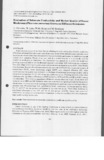Please use this identifier to cite or link to this item:
https://cris.library.msu.ac.zw//handle/11408/446| Title: | Evaluation of substrate productivity and market quality of oyster mushroom (Pleurotus ostreatus) grown on different substrates | Authors: | Chitamba, J. Dube, F. Chiota, W.M. Handiseni, M. |
Keywords: | Pleurotus ostreatus Substrate productivity |
Issue Date: | 2012 | Publisher: | Academic Journals | Series/Report no.: | International Journal of Agricultural Research;Vol. 7(2) | Abstract: | Substrate is one type of the major factors affecting the yield and quality of oyster mushroom (Pleurotus ostreatus). Six substrates, cotton lint waste, maize stover, jatropha cake, corncobs, wood shavings and wheat straw were evaluated for their productivity and impact on mushroom market quality of P. ostreatus. Wheat straw was used as a control because it is commonly used for mushroom production in Zimbabwe. The experiment was carried out in a low cost mushroom growing house and laid out in a randomized complete block design with each treatment replicated four times. Bags containing the pasteurized substrates were spawned at a rate of 8%. Three flushes were harvested from which substrate productivity was evaluated by determining mean number of basidiocarps (MNB), mean basidiocarp weight (MBW) and biological efficiency (BE) while mushroom market quality was evaluated on the basis of basidiocarp percentage number within pileus diameter groups; >7, 5-7, 3-5, <3 cm and a deformed group. Fruiting occurred in the other substrates with significant differences in MBW (p0.001), MNB (p<0.05) and BE (p0.001) among the substrates. There were no significant differences among cotton lint waste, wheat straw and maize stover in MBW and BE. However, cotton lint waste had the highest productivity followed by wheat straw. Corncobs and wood shavings performed poorly and there were no fruiting bodies on jatropha cake. Wood shavings had significantly lower basidiocarp percentage number within the >7 and 5-7 cm size groups and highest in the deformed group. There were, however, no significant differences in the 3-5 and <3 cm size groups (p>0.05). Cotton lint waste and maize stover are competent alternatives to wheat straw as they are equally productive and produce high market quality mushrooms. | URI: | http://hdl.handle.net/11408/446 | ISSN: | 1816-4897 |
| Appears in Collections: | Research Papers |
Files in This Item:
| File | Description | Size | Format | |
|---|---|---|---|---|
| Evaluation of substrate productivity and market quality of oyster mushroom (pleurotus ostreatus) grown on different substrates.pdf | 1.43 MB | Adobe PDF |  View/Open |
Page view(s)
154
checked on Apr 7, 2025
Download(s)
156
checked on Apr 7, 2025
Google ScholarTM
Check
Items in MSUIR are protected by copyright, with all rights reserved, unless otherwise indicated.



